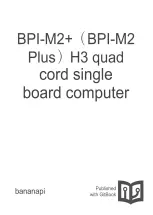
JK
microsystems
µFlashTCP-EP
User’s Manual
2
Operation
The µFlashTCP-EP is configured with two ‘disk drives’ A: and B:. Drive A: contains the
operating system, the BIOS, and utility programs essential to the operation of the µFlashTCP-EP.
Drive A: is read-only. Drive B: is read/write and contains optional utility programs and is
available for user files and applications.
The serial port commonly known as COM2 is the console for the µFlashTCP-EP. The port is
configured for 9600 baud, 8 data bits, 1 stop bit and no parity. This is the primary mode of
communicating with the µFlashTCP-EP. DOS and the BIOS treat the console port as the logical
devices STDIN and STDOUT. The default console speed can be changed using the
SETBAUD
.COM
utility.
B:\>setbaud
Set console baud rate
Usage: setbaud 9600
Possible baud rates: 1200, 2400, 4800, 9600, 19k, 38k, 56k
Version 1.0 for 386Ex based products
B:\>setbaud 9600
Baud rate change will take effect after next reboot
B:\>
When power is applied to the µFlashTCP-EP or when it is reset, the board goes through its
initialization procedure and then starts DOS. A simple
AUTOEXEC.BAT
file is executed and then
the board is ready to use. The batch file performs several functions before the user is given
control. The DOS search path is set, the DOS prompt is set, the CTRL-C flag (discussed later in
this manual) is checked and finally, an attempt is made to execute a file named STARTUP on the
B: drive. This provides a convenient way for custom applications to execute immediately after
initialization of the µFlashTCP-EP. If you wish to have your application start automatically,
create a batch file named
STARTUP.BAT
that invokes the program. It is possible, but not
recommended, to rename your application
STARTUP.EXE
or
STARTUP.COM
. If this is done and
the program locks up, typing CNTL-C at bootup may not break the program and exit to the DOS
prompt.
!
Although the flash memory devices used have a guaranteed lifetime of over 10,000 write
cycles, it is possible for an application to quickly wear them out. The flash memory is
intended to store programs and setup data which is normally not changed. Avoid storing
data or frequently changed information on the flash disk.
Operation
Содержание 89-0040
Страница 1: ...µFlashTCP EP User s Manual ...
Страница 2: ......
Страница 6: ...JKmicrosystems µFlashTCP EP User s Manual iv ...




























